What'sNEW
April - June 2017
 Icy Water Moons That Might Host Life (Infographic), by Calla Cofield, Space.com, 06 Jun 2017. Icy Water Moons That Might Host Life (Infographic), by Calla Cofield, Space.com, 06 Jun 2017.
 Life on Europa...? has related links. Life on Europa...? has related links.
 Thanks, Ronnie McGhee. Thanks, Ronnie McGhee.
 Xenon isotopes in 67P/Churyumov-Gerasimenko show that comets contributed to Earth's atmosphere by B. Marty et al., doi:10.1126/science.aal3496, Science, 09 Jun 2017. Xenon isotopes in 67P/Churyumov-Gerasimenko show that comets contributed to Earth's atmosphere by B. Marty et al., doi:10.1126/science.aal3496, Science, 09 Jun 2017.
 Xenon came from comets, Nature News, 08 Jun 2017. Xenon came from comets, Nature News, 08 Jun 2017.
 Comets: The Delivery System has related information. Comets: The Delivery System has related information.
Geological reconstructions from Curiosity rover data have revealed an ancient, habitable lake environment that was sustained for tens of thousands to tens of millions of years by rivers draining into the crater. ...Previously reported detections of organic carbon compounds, nitrogen, phosphate minerals, and Fe and S minerals in a variety of redox states, combined with the evidence presented here for relatively stable climate conditions and gradients in fluid oxidation state, provide compelling evidence that all of the physical, chemical, and energetic conditions necessary to establish a habitable environment were present on Mars between ~3.8 billion and 3.1 billion years ago.
 Redox stratification of an ancient lake in Gale crater, Mars by J. A. Hurowitz et al., doi:10.1126/science.aah6849, v 356 p 922, Science, 02 Jun 2017. Redox stratification of an ancient lake in Gale crater, Mars by J. A. Hurowitz et al., doi:10.1126/science.aah6849, v 356 p 922, Science, 02 Jun 2017.
 Diagenetic silica enrichment and late-stage groundwater activity in Gale crater, Mars by J. Frydenvang et al., doi:10.1002/2017GL073323, Geophysical Research Letters, 30 May 2017. Diagenetic silica enrichment and late-stage groundwater activity in Gale crater, Mars by J. Frydenvang et al., doi:10.1002/2017GL073323, Geophysical Research Letters, 30 May 2017.
 'Halos' on Mars Suggest Conditions for Life Lasted Longer Than Thought, by Mike Wall, Space.com, 30 May 2017. 'Halos' on Mars Suggest Conditions for Life Lasted Longer Than Thought, by Mike Wall, Space.com, 30 May 2017.
 A fossil on Mars resembles one on Earth, posted 28 Oct 2015: This claim deserves another look, because the strongest argument against it — conditions were never right — has been overturned. A fossil on Mars resembles one on Earth, posted 28 Oct 2015: This claim deserves another look, because the strongest argument against it — conditions were never right — has been overturned.
 Life on Mars! is the main related local webpage. Life on Mars! is the main related local webpage.
 Thanks, Ronnie McGhee for a link and a witty reply. Thanks, Ronnie McGhee for a link and a witty reply.
Officials with Russia's space agency, Roscosmos, say their scientists have identified plankton and other microorganisms among dust samples collected from the outside of the International Space Station. ...Russian scientists believe the ISS spends the majority of its time orbiting through dust left behind by the tails of comets.
 Russia thinks microorganisms may be living outside the space station, by Brooks Hays, UPI.com, 26 May 2017. Russia thinks microorganisms may be living outside the space station, by Brooks Hays, UPI.com, 26 May 2017.
 Russia looks for traces of extra-terrestrial life forms on ISS surface, TAAS, 26 May 2017. Russia looks for traces of extra-terrestrial life forms on ISS surface, TAAS, 26 May 2017.
 Russian Scientists Say Alien Life May Exist on the Surface of the ISS , JohnThomas Didymus, Inquisitr, 10 Jun 2017. Russian Scientists Say Alien Life May Exist on the Surface of the ISS , JohnThomas Didymus, Inquisitr, 10 Jun 2017.
 Thanks, Chandra Wickramasinghe. Thanks, Chandra Wickramasinghe.
 Bacteria... and Bacteria... and  Comets... are related webpages. Comets... are related webpages.
 Teaching genetics prior to teaching evolution improves evolution understanding but not acceptance by Rebecca Mead, Momna Hejmadi and Laurence D. Hurst, doi:10.1371/journal.pbio.2002255, PLoS, 23 May 2017. Teaching genetics prior to teaching evolution improves evolution understanding but not acceptance by Rebecca Mead, Momna Hejmadi and Laurence D. Hurst, doi:10.1371/journal.pbio.2002255, PLoS, 23 May 2017.
 Evolution versus Creationism has related discussion and links. The understanding of genetics reveals issues neither anticipated nor explained by the mainstream theory of evolution. Evolution versus Creationism has related discussion and links. The understanding of genetics reveals issues neither anticipated nor explained by the mainstream theory of evolution.
It has become clear that protein-coding genes can originate de novo from non-coding sequences. This is surprising, because amyloid is a generic structural form of any polypeptide, making the expression of random polypeptides a dangerous affair. De novo gene birth is a radical evolutionary transition....
 Young genes are highly disordered as predicted by the preadaptation hypothesis of de novo gene birth by B. A. Wilson, S. G. Foy, R. Neme & J. Masel, doi:10.1038/s41559-017-0146, Nat. Ecol. Evol., online 24 Apr 2017. Young genes are highly disordered as predicted by the preadaptation hypothesis of de novo gene birth by B. A. Wilson, S. G. Foy, R. Neme & J. Masel, doi:10.1038/s41559-017-0146, Nat. Ecol. Evol., online 24 Apr 2017.
 Three New Human Genes has become our main page about de novo genes. We have added some references there. Three New Human Genes has become our main page about de novo genes. We have added some references there.
| 22 May 2017 |
What'sNEW about HGT  | | |
Retrotransposons often carry long terminal repeats (LTRs) for retroviruslike reverse transcription and integration into the genome. ...Altogether, ERVL LTRs provide molecular mechanisms for stochastically scanning, rewiring, and recycling genetic information on an extraordinary scale.
 Long terminal repeats power evolution of genes and gene expression programs in mammalian oocytes and zygotes, by Vedran Frankeet al., doi:10.1101/gr.216150.116, Genome Res., online 17 May 2017. Long terminal repeats power evolution of genes and gene expression programs in mammalian oocytes and zygotes, by Vedran Frankeet al., doi:10.1101/gr.216150.116, Genome Res., online 17 May 2017.
 Viruses and Other Gene Transfer Mechanisms cites more examples of retrotransposons affecting evolution. Viruses and Other Gene Transfer Mechanisms cites more examples of retrotransposons affecting evolution.
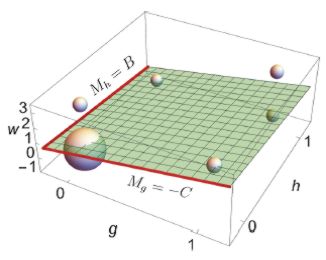
 The general form of Hamilton's rule makes no predictions and cannot be tested empirically | PDF, by Martin A. Nowak et al., doi:10.1073/pnas.1701805114, PNAS, online 16 May 2017. The general form of Hamilton's rule makes no predictions and cannot be tested empirically | PDF, by Martin A. Nowak et al., doi:10.1073/pnas.1701805114, PNAS, online 16 May 2017.
 Neo-Darwinism: The Current Paradigm describes several major problems with standard darwinism, with links to updates. Neo-Darwinism: The Current Paradigm describes several major problems with standard darwinism, with links to updates.
 ...Tiny Interstellar Probes May Test 'Panspermia' Idea, by Mike Wall, Space.com, 10 May 2017. ...Tiny Interstellar Probes May Test 'Panspermia' Idea, by Mike Wall, Space.com, 10 May 2017.
 Thanks, Ronnie McGhee and Google Alerts. Thanks, Ronnie McGhee and Google Alerts.
 How Is It Possible includes related speculation. How Is It Possible includes related speculation.
The oxygen produced on comet 67P prompts a new theory from a chemical engineer.
 Comet 67P is making its own oxygen gas, by Alison Klesman, Astronomy Magazine, 09 May 2017. Comet 67P is making its own oxygen gas, by Alison Klesman, Astronomy Magazine, 09 May 2017.
 Thanks, Richard Hoover, for commenting: microbial life is a likelier explanation for the oxygen. Thanks, Richard Hoover, for commenting: microbial life is a likelier explanation for the oxygen.
 On the origin of molecular oxygen in cometary comae by K. L. Heritier et al., Nature Communications, 03 Jul 2018. On the origin of molecular oxygen in cometary comae by K. L. Heritier et al., Nature Communications, 03 Jul 2018.
 Thanks, Cody Bennett. Thanks, Cody Bennett.
 Comet Rendezvous has links to all our news about the Rosetta mission. Comet Rendezvous has links to all our news about the Rosetta mission.
...the planets most conducive to the development and maintenance of a pervasive biosphere will often be challenging to characterize via conventional atmospheric biosignatures.
 False Negatives for Remote Life Detection on Ocean-Bearing Planets: Lessons from the Early Earth [PDF], by Christopher T Reinhard et al., doi:10.1089/ast.2016.1598, Astrobiology, 01 Apr 2017. False Negatives for Remote Life Detection on Ocean-Bearing Planets: Lessons from the Early Earth [PDF], by Christopher T Reinhard et al., doi:10.1089/ast.2016.1598, Astrobiology, 01 Apr 2017.
 Gaia is a related local webpage. Gaia is a related local webpage.
The prevalence of life on Earth, in all kinds of 'extreme' environments, and the fact that life arose fairly early on in Earth's history, makes it hard to believe there isn't some sort of microscopic life on the other planets and moons in our solar system — Rebecca Mickol, Arkansas Center for Space and Planetary Science
 Microbes could survive thin air of Mars, by Charles Q. Choi, Astrobiology Magazine (+PhysOrg.com), 16 Jan 2017. Microbes could survive thin air of Mars, by Charles Q. Choi, Astrobiology Magazine (+PhysOrg.com), 16 Jan 2017.
 Low Pressure Tolerance by Methanogens in an Aqueous Environment: Implications for Subsurface Life on Mars, by Rebecca Mickol and Timothy Kral, doi:10.1007/s11084-016-9519-9, Orig Life Evol Biosph, online 23 Sep 2016. Low Pressure Tolerance by Methanogens in an Aqueous Environment: Implications for Subsurface Life on Mars, by Rebecca Mickol and Timothy Kral, doi:10.1007/s11084-016-9519-9, Orig Life Evol Biosph, online 23 Sep 2016.
 Life on Mars! has more. Search for "methane". Life on Mars! has more. Search for "methane".
 Thanks, Ronnie McGhee. Thanks, Ronnie McGhee.
 Related links, 2-6 Mar 2017. Related links, 2-6 Mar 2017.
 Survival and DNA Damage in Plant Seeds Exposed for 558 and 682 Days outside the International Space Station [PDF], David Tepfer and Sydney Leach, doi:10.1089/ast.2015.1457, Astrobiology, online 06 Mar 2017. Survival and DNA Damage in Plant Seeds Exposed for 558 and 682 Days outside the International Space Station [PDF], David Tepfer and Sydney Leach, doi:10.1089/ast.2015.1457, Astrobiology, online 06 Mar 2017.
 Morning glory seeds are tough enough for an interplanetary trip, Katherine Kornei, doi:10.1126/science.aal1137, Science, online 01 May 2017. Morning glory seeds are tough enough for an interplanetary trip, Katherine Kornei, doi:10.1126/science.aal1137, Science, online 01 May 2017.
 Thanks, Chandra Wickramasinghe. Thanks, Chandra Wickramasinghe.
The Hubble Telescope imaged a 62-mile-high plume of water on Europa, in Feb 2016. It was in the same location as a plume seen two years earlier. NASA says that Europa Clipper, a planned mission, could fly through the plume to take samples. If Europa's ocean harbors life, the plume should contain evidence of it.
 Active Cryovolcanism on Europa? W. B. Sparks et al., n2, v839, The Astrophysical Journal Letters, 13 Apr 2017. Active Cryovolcanism on Europa? W. B. Sparks et al., n2, v839, The Astrophysical Journal Letters, 13 Apr 2017.
 Europa Water Vapor Plumes - More Hubble Evidence, NASA's Goddard Space Flight Center, 13 Apr 2017. Europa Water Vapor Plumes - More Hubble Evidence, NASA's Goddard Space Flight Center, 13 Apr 2017.
 Hubble Spots Possible Venting Activity on Europa, HubbleSite, 13 Apr 2017. Hubble Spots Possible Venting Activity on Europa, HubbleSite, 13 Apr 2017.
 Life on Europa...? has related links. Life on Europa...? has related links.
 The abundance of H2... introduces related news about Enceladus, 13 Apr 2017. The abundance of H2... introduces related news about Enceladus, 13 Apr 2017.
 George Nickas wonders when we will actually look for life itself, 21 Apr 2017. George Nickas wonders when we will actually look for life itself, 21 Apr 2017.
| 17 Apr 2017 |
What'sNEW about HGT  | | |
We have analyzed the genomes from 195 insect species and found that no fewer than 2,248 events of HT of TEs occurred during the last 10 My. ...Even though our study is restricted to a small fraction of insect biodiversity and to a recent evolutionary timeframe, the TEs we found to be horizontally transferred generated up to 24% (2.08% on average) of all nucleotides of insect genomes. ...Extrapolating our estimates over the ~480 My of insect evolution and the whole insect biodiversity points toward millions of HTT events generating substantial fractions of insect genomes. ...Together, our results establish HTT as a major force shaping insect genome.
 Massive horizontal transfer of transposable elements in insects, Jean Peccoud et al., doi:10.1073/pnas.1621178114, PNAS, online 17 Apr 2017. Massive horizontal transfer of transposable elements in insects, Jean Peccoud et al., doi:10.1073/pnas.1621178114, PNAS, online 17 Apr 2017.
 Viruses and Other Gene Transfer Mechanisms cites many more examples of HGT affecting eukaryotes. Viruses and Other Gene Transfer Mechanisms cites many more examples of HGT affecting eukaryotes.
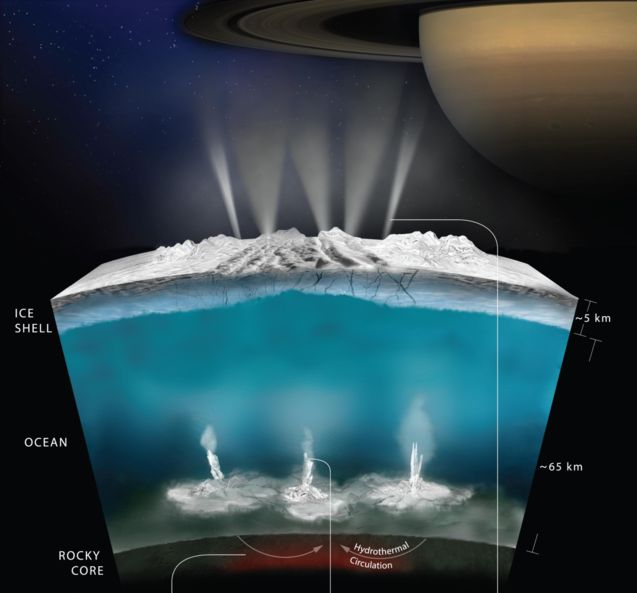 The abundance of H2 along with previously observed carbonate species suggests a state of chemical disequilibria in the Enceladus ocean that represents a chemical energy source capable of supporting life.
The abundance of H2 along with previously observed carbonate species suggests a state of chemical disequilibria in the Enceladus ocean that represents a chemical energy source capable of supporting life.
 Cassini finds molecular hydrogen in the Enceladus plume: Evidence for hydrothermal processes, by J. Hunter Waite et al., doi:10.1126/science.aai8703; and commentary: Detecting molecular hydrogen on Enceladus by Jeffrey S. Seewald, Science, 14 Apr 2017. Cassini finds molecular hydrogen in the Enceladus plume: Evidence for hydrothermal processes, by J. Hunter Waite et al., doi:10.1126/science.aai8703; and commentary: Detecting molecular hydrogen on Enceladus by Jeffrey S. Seewald, Science, 14 Apr 2017.
 Saturn moon 'able to support life' by Jonathan Amos, BBC, 13 Apr 2017. Saturn moon 'able to support life' by Jonathan Amos, BBC, 13 Apr 2017.
 NASA Missions Provide New Insights into 'Ocean Worlds' in Our Solar System, NASA, 13 Apr 2017. NASA Missions Provide New Insights into 'Ocean Worlds' in Our Solar System, NASA, 13 Apr 2017.
This is the closest we've come, so far, to identifying a place with some of the ingredients needed for a habitable environment.
 Thanks, Ellen Klyce, NPR, Bob Sweeney and John Bilon. Thanks, Ellen Klyce, NPR, Bob Sweeney and John Bilon.
 Life on Europa, Other Moons, Other Planets?... has related links. Life on Europa, Other Moons, Other Planets?... has related links.
 George Nickas wonders when we will actually look for life itself, 21 Apr 2017. George Nickas wonders when we will actually look for life itself, 21 Apr 2017.
 Life on Enceladus, Chandra Wickramasinghe's letter to The Times, London, 17 Apr 2017. Life on Enceladus, Chandra Wickramasinghe's letter to The Times, London, 17 Apr 2017.
 Tardigrade in Moss, Astronomy Picture of the Day, 26 Mar 2017. Earlier, about tardigrades: Tardigrade in Moss, Astronomy Picture of the Day, 26 Mar 2017. Earlier, about tardigrades:



| 07 Apr 2017 |
What'sNEW about HGT  | | |
...Klosneuviruses encode an expanded translation machinery, including aminoacyl transfer RNA synthetases with specificities for all 20 amino acids. An international collaboration of genomicists, using samples from a wastewater treatment plant in Austria, assembled the genome of this newly identified group of giant dsDNA viruses. Studying clues of its phylogenic history, they place it among mimiviruses, although ...the biological underpinning of the high content of translation-related genes ...is uncertain....
Viruses cannot conduct cellular metabolism and have no apparent use for the translation genes that all cells contain. In the standard theory of evolution, the presence of translation genes in viruses is a challenge to explain. In cosmic ancestry, viruses are a principle means of horizontal gene transfer (HGT), so we expect them often to carry genes that only cells can use.
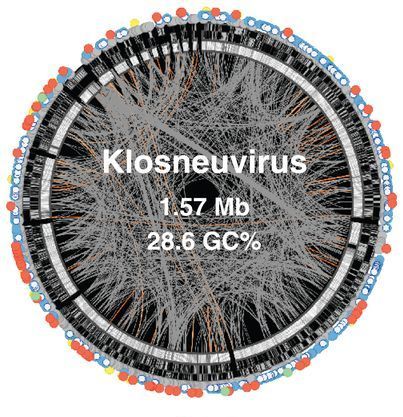
The illustration shows genome bins of the Klosneuviruses. From outside to inside: solid circles indicate genes exclusively shared with nucleocytoplasmic large DNA viruses (NCLDVs) (blue), genes specific for Klosneuviruses (white), genes shared with eukaryotes (red), genes shared with Bacteria (green), genes represented in all three domains of cellular life (yellow), and singletons (gray). The second ring displays positions of genes (gray) either on the minus or the plus strand. ...Links connect paralogs.... (excerpted from Schulz et al.)
 Giant viruses with an expanded complement of translation system components, by Frederik Schulz et al., doi:10.1126/science.aal4657, Science, 07 Apr 2017. Giant viruses with an expanded complement of translation system components, by Frederik Schulz et al., doi:10.1126/science.aal4657, Science, 07 Apr 2017.
 Cell-like giant viruses found, by Mitch Leslie, Science, 07 Apr 2017. Cell-like giant viruses found, by Mitch Leslie, Science, 07 Apr 2017.
 Discovered: Novel Group of Giant Viruses, DOE Joint Genome Institute (+Newswise), 06 Apr 2017. Discovered: Novel Group of Giant Viruses, DOE Joint Genome Institute (+Newswise), 06 Apr 2017.
 ...giant viruses present an astonishing arsenal of genes...., 17 Feb 2017. ...giant viruses present an astonishing arsenal of genes...., 17 Feb 2017.
 Viruses and Other Gene Transfer Mechanisms points to many more examples of cellular genes in viruses. Viruses and Other Gene Transfer Mechanisms points to many more examples of cellular genes in viruses.
| 05 Apr 2017 |
What'sNEW about HGT  | | |
...there might be hundreds or even more than a thousand predicted HGT regions in the human genome.
 Widespread of horizontal gene transfer in the human genome, by Wenze Huang et al., doi:10.1186/s12864-017-3649-y, BMC Genomics, 04 Apr 2017. Widespread of horizontal gene transfer in the human genome, by Wenze Huang et al., doi:10.1186/s12864-017-3649-y, BMC Genomics, 04 Apr 2017.
 Thanks, Google Alerts. Thanks, Google Alerts.
 Viruses and Other Gene Transfer Mechanisms is our main related webpage. Viruses and Other Gene Transfer Mechanisms is our main related webpage.
A conference in Cambridge MA, April 3-4, celebrates the tenth-anniversary of the inauguration of Harvard University's Origins of Life Initiative. Introducing the sessions, founding Director Dimitar Sasselov outlined a 3-point research program comprising metabolism (proteins), information (nucleotides) and containers (lipids). A lecture by Nobel laureate Jack Szostak and panel discussions on "The Chemistry of Life's Origins" followed. The software problem got no mention, but even the hardware problem was judged to be virtually insurmountable by Harvard chemist George Whitesides. Panelist Steven Benner suggested that if Whitesides is right, creationism could be the default solution!?
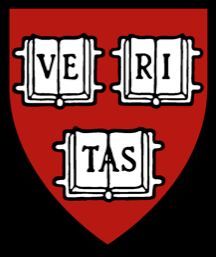 During question-and-answer, I polled the (150 or so?) attendees: does anyone think the just-described chiral organic molecules in meteorites might be, not pre-, but post-biotic? Two hands went up. One was Gary Ruvkun of SETG. He favors panspermia, but believes the RNA World might succeed if the warm little pond includes the whole big-bang universe. He sat by RNA World pioneer Walter Gilbert, whom I was honored to meet.
During question-and-answer, I polled the (150 or so?) attendees: does anyone think the just-described chiral organic molecules in meteorites might be, not pre-, but post-biotic? Two hands went up. One was Gary Ruvkun of SETG. He favors panspermia, but believes the RNA World might succeed if the warm little pond includes the whole big-bang universe. He sat by RNA World pioneer Walter Gilbert, whom I was honored to meet.
Over lunch I showed a NASA photo of the crinoid-like fossil on Mars (taken by the Opportunity rover in 2004) to a few at my table. They reluctantly glanced at it. I also showed them one SEM image of fossilized germs from the Orgueil meteorite (published by Richard Hoover in 2011). Benner, a biochemist, rejects these images because Hoover has never revealed all of his other, less interesting ones. Huh?
Biochemist Ann Pearson and astronomer David Charbonneau had the most exciting news of the afternoon, the ballooning knowledge of extra-solar Earthlike planets orbiting within the "Goldilocks" zones of long-lived red M-dwarf stars. About 250 such planets are known to lie within 10 parsecs of Earth, close enough to examine in detail with powerful new instruments including the orbiting James Webb Space Telescope, scheduled for launch in 2018.
More than one speaker commented that the astrobiology community is a fractious one. Right. And they are smart, dedicated, and committed to their principles. I regret having to miss the second half of the conference, which will consider "The Future of the Field".
 Understanding life, here, there, and everywhere, by Alvin Powell, Harvard Gazette, 05 Apr 2017. Understanding life, here, there, and everywhere, by Alvin Powell, Harvard Gazette, 05 Apr 2017.
 Harvard's Origins of Life program held its inaugural symposium in Cambridge MA, 08 Nov 2006. Harvard's Origins of Life program held its inaugural symposium in Cambridge MA, 08 Nov 2006.
 A notice about the crinoid-like fossil on Mars, posted 28 Oct 2015. A notice about the crinoid-like fossil on Mars, posted 28 Oct 2015.
 Fossilized germs from the Orgueil meteorite are shown here, with links, posted 03 Mar 2011. Fossilized germs from the Orgueil meteorite are shown here, with links, posted 03 Mar 2011.
 The RNA World, our webpage about origin-of-life theories, includes more about Walter Gilbert. The RNA World, our webpage about origin-of-life theories, includes more about Walter Gilbert.
 SETG and Gary Ruvkun are glimpsed here, 06 Jan 2017. SETG and Gary Ruvkun are glimpsed here, 06 Jan 2017.
|
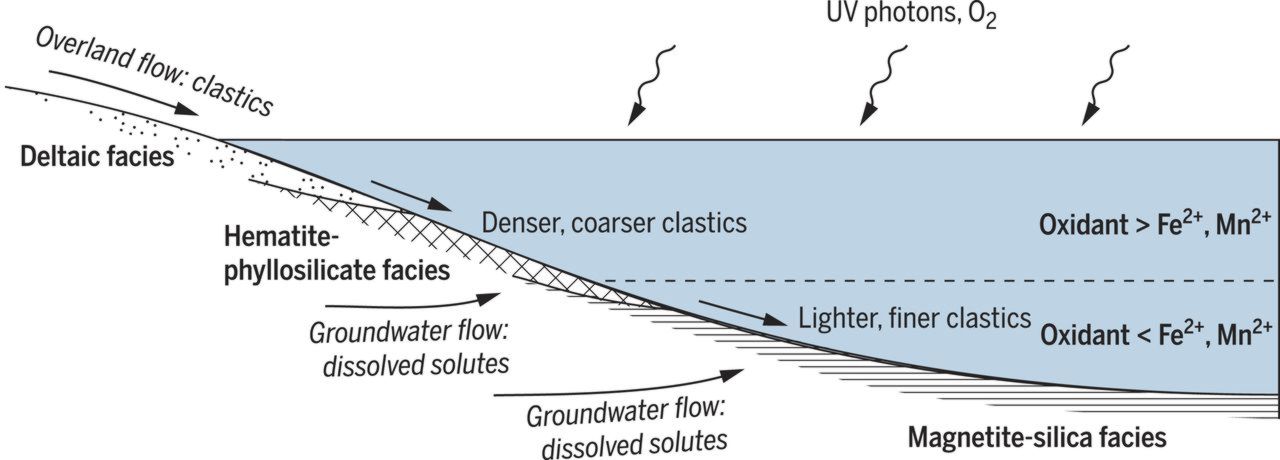

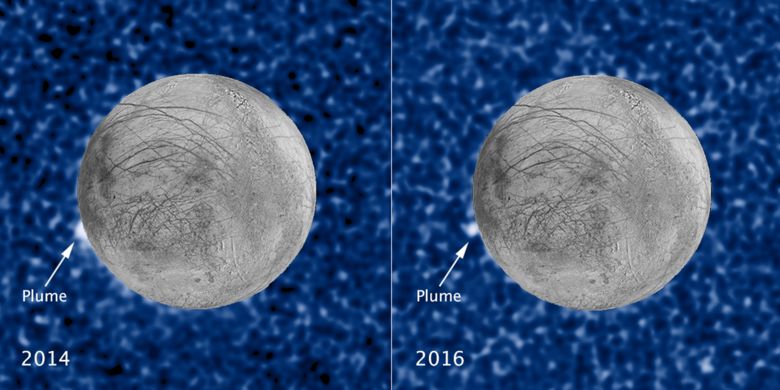
 The abundance of H2 along with previously observed carbonate species suggests a state of chemical disequilibria in the Enceladus ocean that represents a chemical energy source capable of supporting life.
The abundance of H2 along with previously observed carbonate species suggests a state of chemical disequilibria in the Enceladus ocean that represents a chemical energy source capable of supporting life.
 During question-and-answer, I polled the (150 or so?) attendees: does anyone think the just-described chiral organic molecules in meteorites might be, not pre-, but post-biotic? Two hands went up. One was Gary Ruvkun of SETG. He favors panspermia, but believes the RNA World might succeed if the warm little pond includes the whole big-bang universe. He sat by RNA World pioneer Walter Gilbert, whom I was honored to meet.
During question-and-answer, I polled the (150 or so?) attendees: does anyone think the just-described chiral organic molecules in meteorites might be, not pre-, but post-biotic? Two hands went up. One was Gary Ruvkun of SETG. He favors panspermia, but believes the RNA World might succeed if the warm little pond includes the whole big-bang universe. He sat by RNA World pioneer Walter Gilbert, whom I was honored to meet.